Before there was soap in the New World, there was Jewelweed to aid those who strolled or rolled in the poison ivy patch. The two varieties that we see around the land of weedom are the spotted orange flowered Impatiens capensis (which used to be Impatiens fulva) and yellow flowered Impatiens pallida.
At weedom, we have a long relationship with jewelweed, because of the even longer relationship with poison ivy, Toxicodendron radicans, which is all over this place. It became imperative to make use of jewelweed to mitigate the skin eruptions which are almost unavoidable for people who wander through the weeds, clear fence lines, chop wood and weed gardens. The largest original jewelweed stands occupied each end of the creek which runs through the middle of the farm. Since we used these weeds, we spread the seeds, and created a new stand around our personal swamp and greenhouse. This area also collects runoff from a barn roof and therefore has supported jewelweed well, even through this unusually dry spring and summer. Now, at the early part of the flowering season, is our optimal time for collecting Jewelweed for the medicinal purposes. During this time, until fall, we normally get visits from hummingbirds which are attracted to the blooms.
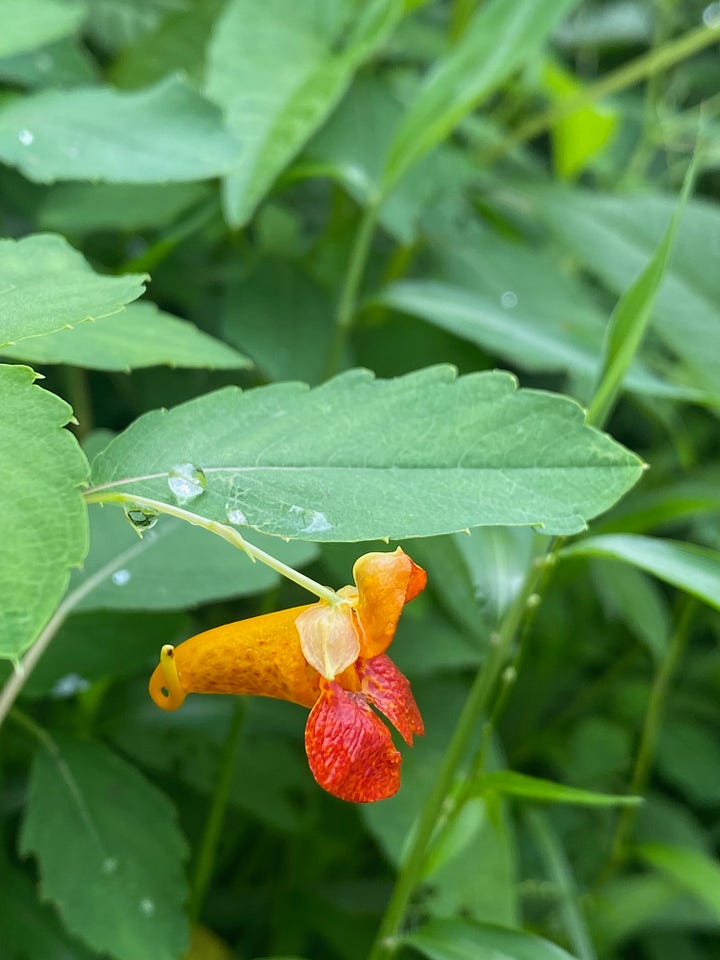
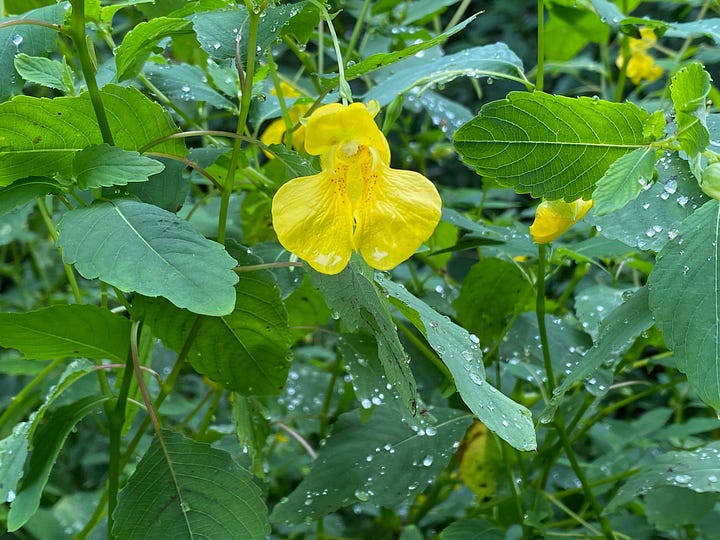
Jewelweed gets its name from the look of the raindrops or dew which form shiny spheres on the leaves of this plant. In addition to its use to prevent disastrous skin eruptions from poison ivy exposure, it has antifungal properties, and can be eaten as food. Stems of young plants can be cut and cooked to a texture a little bit like green beans. The flowers are edible, as are the seeds and seed pods. This is one of the many calcium oxalate containing weeds, so those stems should be cooked, before eating in normal human proportions, not by the bale.
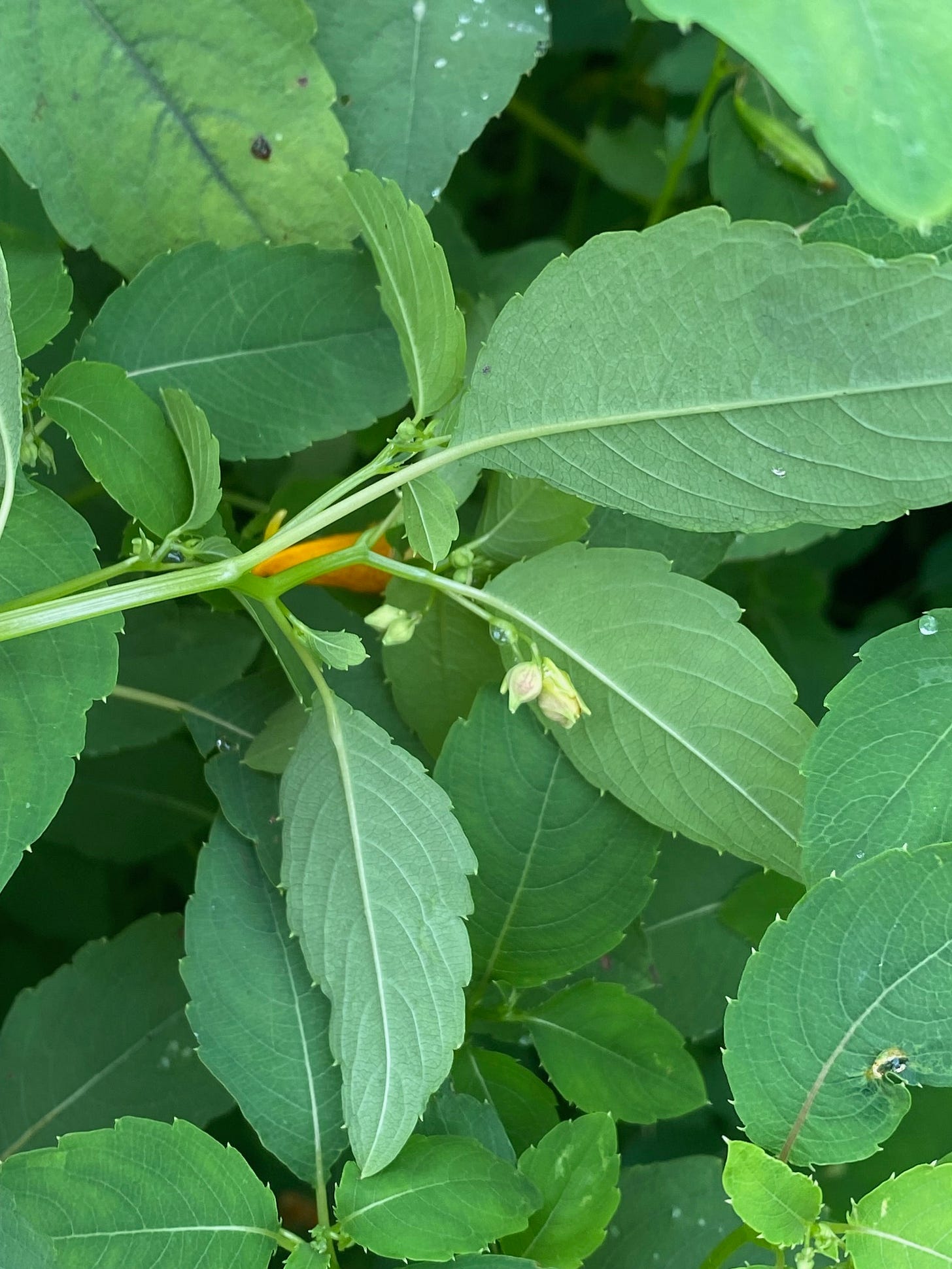
Doing the Botany: Impatiens capensis and pallida are annual plants, belonging to the family Balsamaceae. They are native to North America, and have been spread to Europe, where they have naturalized with little assistance. Jewelweed occupies hardiness zones 2a to 11b Stems are succulent, ribbed, hairless, and have a hollow center. Most of the juice of the plant can be squeezed from the stems.
Roots are rather small for such a large plant, which is why they do best in damp to wet soil. Leaves are blue green on the upper side, silvery green on the lower side, and coarsely toothed. They are oblong, and about twice as long as they are wide. Venation is pinnate. Leaves are about 5-10 cm (1.5 - 3 inches) long, and those of Impatiens pallidum seem to be a bit larger on average than Impatiens capensis, but this is variable. Water beads up on the ‘hydrophobic’ surface of jewelweed leaves. If you dip the leaves in water, they take on a silvery appearance, and when you pull them back out, the water doesn’t cling to them. This is due to a layer of microscopic hairs which traps an air layer against the leaves, and which gives them a matte surface appearance. At the Identify That Plant, site Angelyn shows the comparative details of our two Impatiens species. It turns out that they’re fairly impossible to distinguish by eye until they have flowered.
Flowers are botanically described in variable ways, with different conclusions on the number of true petals and sepals. The blooms dangle from thin stems, arising from leaf axils. The stems appear to connect towards the top front of the bloom, with sepals straddling each side of the flower. The calyx is said to be made of 3 sepals, with the third sepal being the same color as the bloom, and extending to form a nectar spur which is the back end of the flower. 4 or 5 petals form upper and lower lobes of the flower opening. There are 5 stamens (male parts, and the pistil (female part), has 5 carpels which bear the seeds. Fertilization is rather efficient with the aid of insects and hummingbirds. In the early fall, ladybugs can often be found taking shelter in the blooms, which continue until first frost. Jewelweed is also capable of forming little green cleistogamous flowers, like violets do. These flowers never open up, and can self fertilize. The seed pods which form, can explode into 5 curly segments when touched, and send 5 seeds flying. This has inspired another name for the plant: touch-me-not, which also has been applied to other members of the Balsamaceae family. At weedom, we discovered that the seeds are somewhat heat stable, as our new stand was partially started by throwing seeds and plant parts, left over after an extraction in hot water, into our compost pile. We also opened pods before the extraction process, and threw the seeds into our swamp. Years later, there’s jewelweed galore.
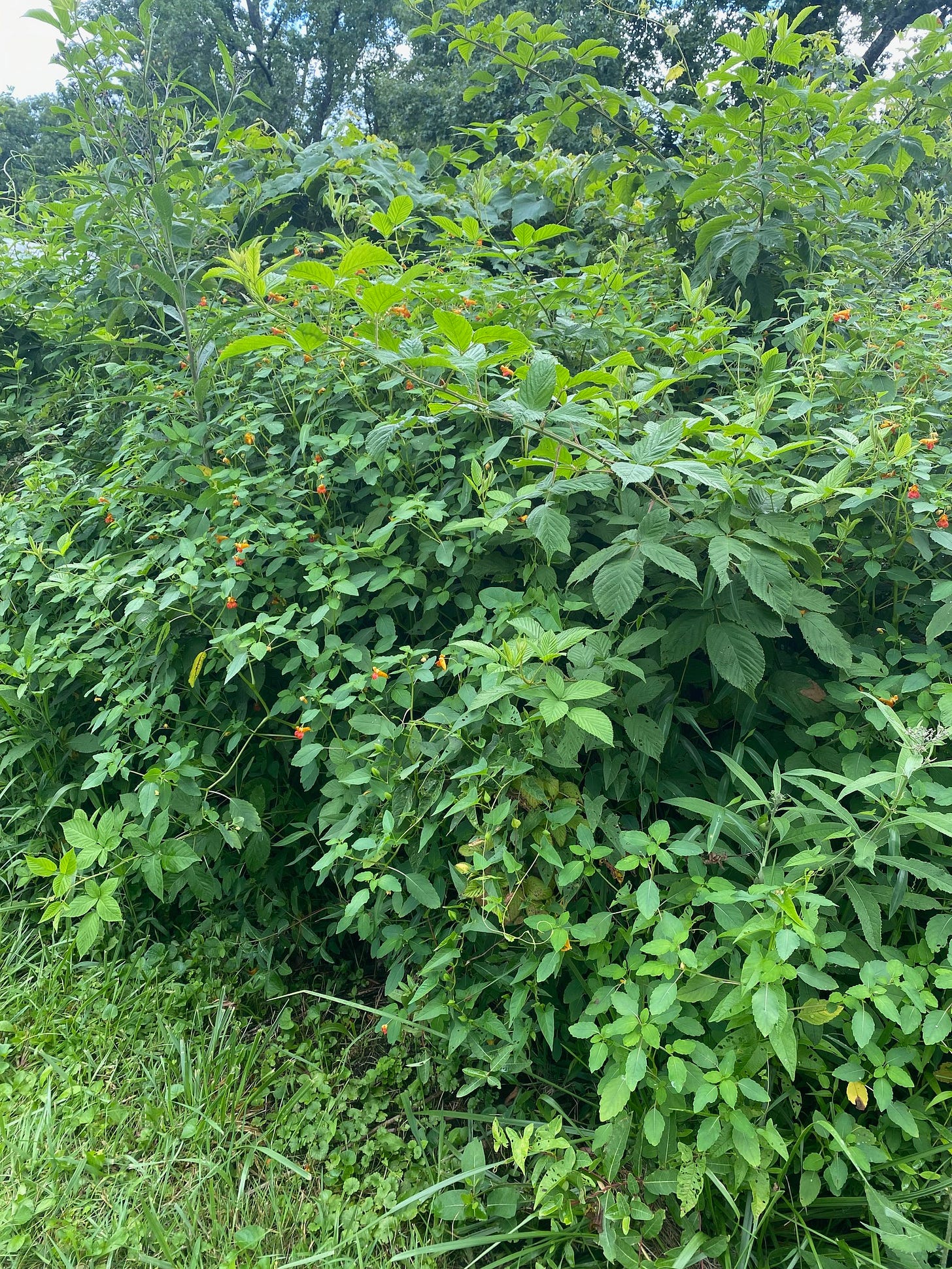
Various Tribes of the earlier native Americans, including Eastern Cherokee, Potawatomi and Chippewa, used jewelweed to treat or prevent poison ivy rashes as well as skin irritations from stinging nettle and insect stings. It was either applied before poison ivy contact, or afterwards.
Lawsone, a.k.a. 2-hydroxy-1,4-naphthoquinone, is the reddish compound found in henna, which is also produced in jewelweed. It’s a structural isomer of juglone, that famous compound of black walnut trees which inhibits growth of various plants around the tree. It’s also an effective topical treatment for skin and nailbed fungal infections. Lawsone has similar activity, which caused Henna to be used similarly, in Ayurvedic medicine, as an antifungal for skin infections and for thrush. It also has demonstrated antioxidant and immunomodulatory properties. Lawsone was formerly credited for the ability of jewelweed to prevent poison ivy rash, but this is no longer thought to be the case.
A weak antihistaminic effect of jewelweed flower extract has been demonstrated in mice. This plant contains quercetin, a compound known to inhibit mast cell degranulation, and therefore might explain that observation, but this is likely not accounting for the traditional, topical use of jewelweed to prevent poison ivy.
Poison ivy rash is caused by a skin reaction to the binding of urushiol a stable, oily substance produced by that plant, which deposits on the skin when you brush up against those weeds. Urushiol doesn’t ooze out of poison ivy rashes, nor does it spread on the skin, once it has been washed off. However it is retained on wood piles, is carried on clothing, can be spread to furnishings, beds and upholstery, and travels on the fur coats of pets, etc. This might explain any ‘mystery’ poison ivy rash that you have experienced. The hypersensitivity reaction is largely credited to CD1 proteins in the skin combining with urushiol, and causing T cells to respond by producing interleukins 17 and 22, which in turn bring on the itching and rash.
About 10 or so years ago, Motz et. al. did most of the work to explain how jewelweed works to prevent poison ivy rash. There hasn’t been much done experimentally since that time. After determining that there wasn’t a dose related response to the lawsone in jewelweed, they noted that jewelweed soap, and regular soap without the jewelweed performed similarly to prevent the rash, and each of these appeared even more effective than the direct application of plant material or juice. From this, they hypothesized that plant saponins might explain the effect. Further experimentation, involving partial isolation of the plant saponins determined that most of this activity of jewelweed did appear to be in the saponin containing fraction derived from the plant. Whole mash of jewelweed left on the poison ivy exposed skin in some experimental participants had the effect of causing a rash of its own, while the saponin fraction seemed to show less of this effect. Jewelweed soap and plain soap had the greatest efficacy in preventing the poison ivy rash, with their level of performance being similar.
Jewelweed mash and extracts seem to do little to lessen a poison ivy rash once it has already formed, but many people report that they cause a decrease in itching, which is in itself a benefit that can help prevent the rash from getting worse or infected.
The take-home message about Jewelweed for poison ivy is that it can be a significant, preventative help when you’ve been exposed to the poison ivy, and can’t immediately jump in the shower to soap off the oily urushiol residue. In addition, the application of mashed jewelweed can possibly lessen the spread of the very stable urushiol oil from one part of your skin to another.
To prevent the deposit of urushiol throughout your house after you’ve been in the poison ivy:
Remove your clothes and throw them in the wash pile to be laundered.
Jump in the shower and wash yourself with soap thoroughly.
Rinse, lather, repeat 1 or 2 more times.
Restrict where your pets go if they’ve been in the poison ivy. Dogs seem to be more of a problem than cats.
These behavioral habits can spare those who are very sensitive to poison ivy a lot of misery, and medical expense. You have between 2 and 8 hours (depending on conditions) to prevent or mitigate the rash by physically removing the urushiol from your skin.
Consider making Jewelweed mash from the aerial parts of the plant, including stems, in water to make it manageable, and freezing it as jewelweed ice cubes. This could help you with the surprise poison ivy encounters of winter and early spring, before the new year’s jewelweed arrives.
Should you bother to use jewelweed soap? Yes, if it’s easy on your skin, and doesn’t dry you out with repeated use. Using good, gentle soap helps prevent itchy skin, and allows it to heal.
This week we will open up the weedom chat room which is an optional place for or our subscribers to interact, discuss weeds, ask or answer questions. A separate email will accompany this one which will tell new SubStack users how to get access to chat. We’ll start with a jewelweed /poison ivy topic, but won’t mind anyone wishing to get further lost in the weeds. :-D
Remember, when we turn on the paid subscription option, that it is optional for the weekly newsletter. We intend for this health asset to remain available to everyone, but want to open the opportunity for those who would like to $upport our mission to increase food and medicine independence for all. Thanks to all our loyal readers for hanging with us.
Where we Dig
1. Abrams Motz V, Bowers CP, Mull Young L, Kinder DH. The effectiveness of jewelweed, Impatiens capensis, the related cultivar I. balsamina and the component, lawsone in preventing post poison ivy exposure contact dermatitis. J Ethnopharmacol. 2012;143(1):314-318. doi:10.1016/j.jep.2012.06.038
2. DerMarderosian A, Buetler J. Review of Natural Products. 8th edition. Lippincott Williams & Wilkins; Facts and Comparisons; 2014. https://openlibrary.org/books/OL27960482M/Review_of_Natural_Products
3. Motz VA, Bowers CP, Kneubehl AR, Lendrum EC, Young LM, Kinder DH. (PDF) Efficacy of the Saponin Component of Impatiens capensis Meerb.in Preventing Urushiol-induced Contact Dermatitis. Journal of Ethnopharmacology. 2015;162:163-167.
4. Grieve M. Modern Herbal. Echo Point Books & Media, LLC.; 2015. https://openlibrary.org/books/OL36722889M/Modern_Herbal
5. medicinal herbs: JEWELWEED - Impatiens capensis. Accessed August 14, 2023. http://naturalmedicinalherbs.net/herbs/i/impatiens-capensis=jewelweed.php
6. Xavier MR, Santos MMS, Queiroz MG, de Lima Silva MS, Goes AJS, De Morais Jr MA. Lawsone, a 2-hydroxy-1,4-naphthoquinone from Lawsonia inermis (henna), produces mitochondrial dysfunctions and triggers mitophagy in Saccharomyces cerevisiae. Mol Biol Rep. 2020;47(2):1173-1185. doi:10.1007/s11033-019-05218-3
7. Jewelweed - Impatiens Capensis: Edible & Medicinal Uses of the Snappiest Wild Plant - Song of the Woods. Accessed May 2, 2023. https://www.songofthewoods.com/jewelweed-impatiens-capensis/
8. Allen S. Jewelweed. Loudoun Wildlife Conservancy. Published October 1, 2005. Accessed August 15, 2023. https://loudounwildlife.org/2005/10/jewelweed/
9. Is it pallida or is it capensis? | Identify that Plant. Accessed August 15, 2023. https://identifythatplant.com/is-it-pallida-or-is-it-capensis/
10. Dananjaya SHS, Udayangani RMC, Shin SY, et al. In vitro and in vivo antifungal efficacy of plant based lawsone against Fusarium oxysporum species complex. Microbiological Research. 2017;201:21-29. doi:10.1016/j.micres.2017.04.011
11. Impatiens.—Jewelweed. | Henriette’s Herbal Homepage. Accessed August 14, 2023. https://www.henriettes-herb.com/eclectic/kings/impatiens.html
12. Impatiens capensis Jewelweed PFAF Plant Database. Accessed August 14, 2023. https://pfaf.org/USER/Plant.aspx?LatinName=Impatiens+capensis
13. Impatiens capensis (Jewelweed, Jewel Weed, Orange Jewelweed, Touch-me-not) | North Carolina Extension Gardener Plant Toolbox. Accessed August 14, 2023. https://plants.ces.ncsu.edu/plants/impatiens-capensis/
14. From leaf to itch – Harvard Gazette. Accessed August 16, 2023. https://news.harvard.edu/gazette/story/2016/09/from-leaf-to-itch/
15. Motz VA, Bowers CP, Kneubehl AR, Lendrum EC, Young LM, Kinder DH. Efficacy of the saponin component of Impatiens capensis Meerb.in preventing urushiol-induced contact dermatitis. Journal of Ethnopharmacology. 2015;162:163-167. doi:10.1016/j.jep.2014.12.024
16. Kim JH, Hu Y, Yongqing T, et al. CD1a on Langerhans cells controls inflammatory skin disease. Nat Immunol. 2016;17(10):1159-1166. doi:10.1038/ni.3523
17. Sarang H, Rajani P, Vasanthakumari MM, et al. An endophytic fungus, Gibberella moniliformis from Lawsonia inermis L. produces lawsone, an orange-red pigment. Antonie van Leeuwenhoek. 2017;110(7):853-862. doi:10.1007/s10482-017-0858-y





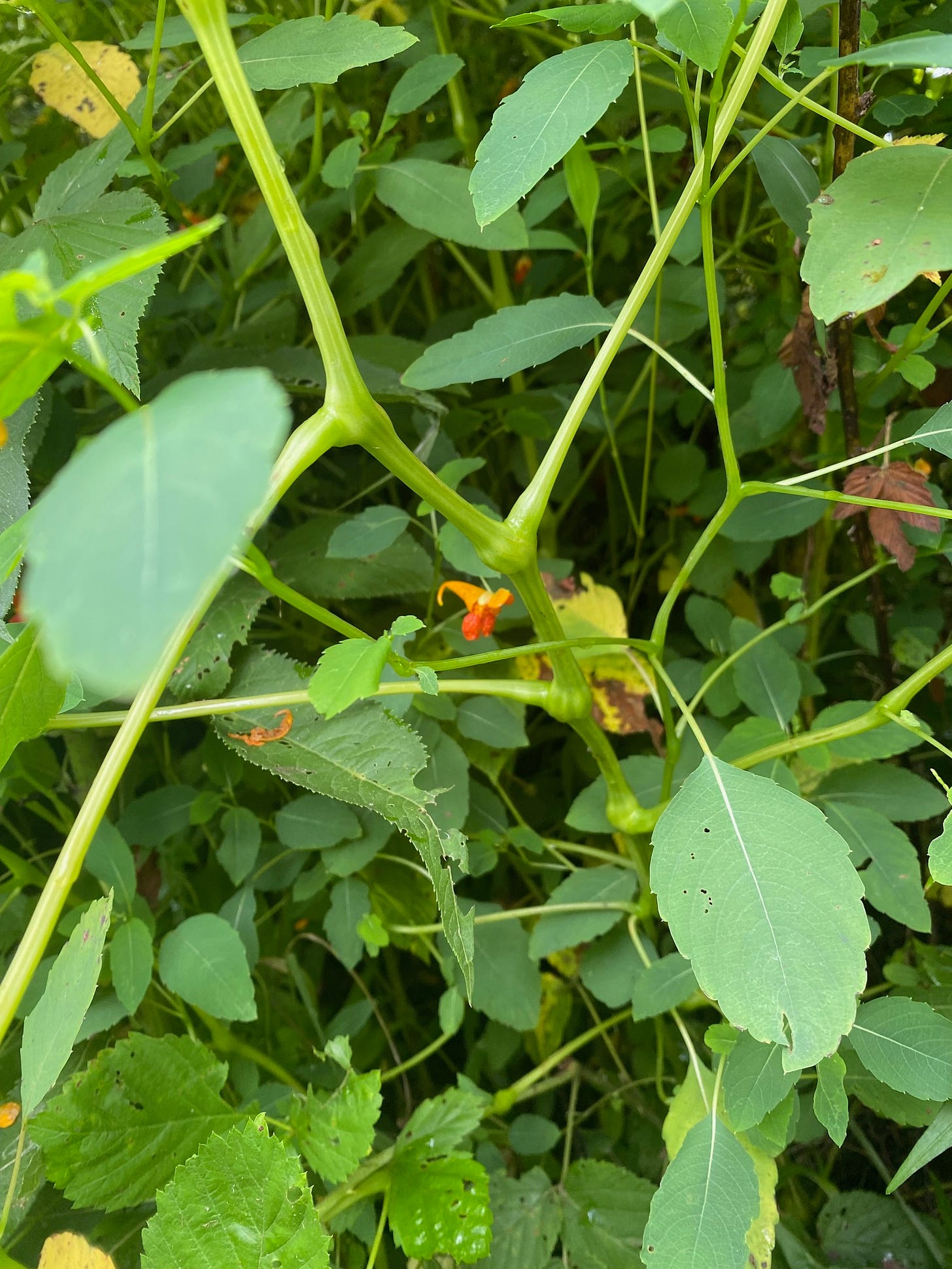
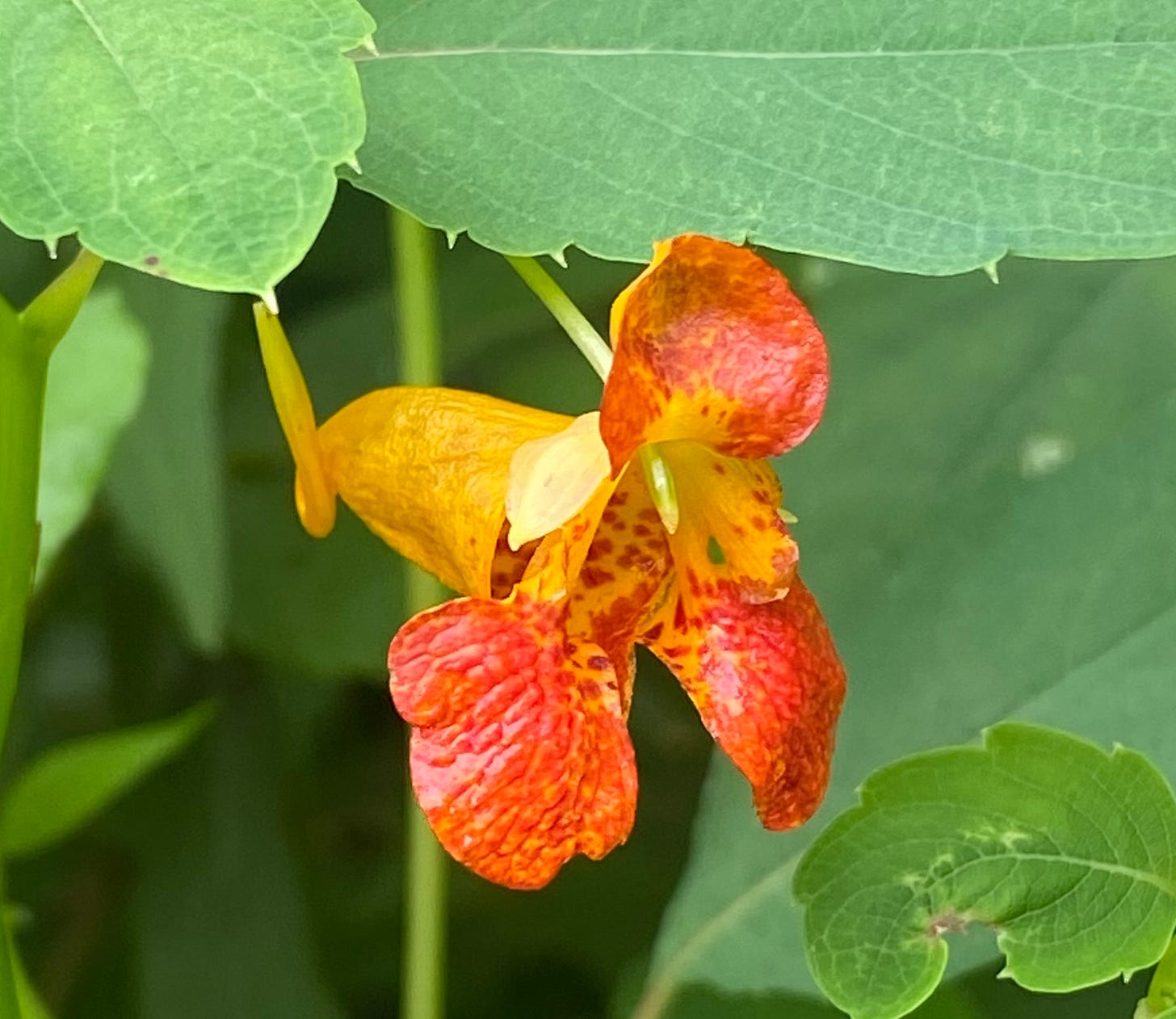
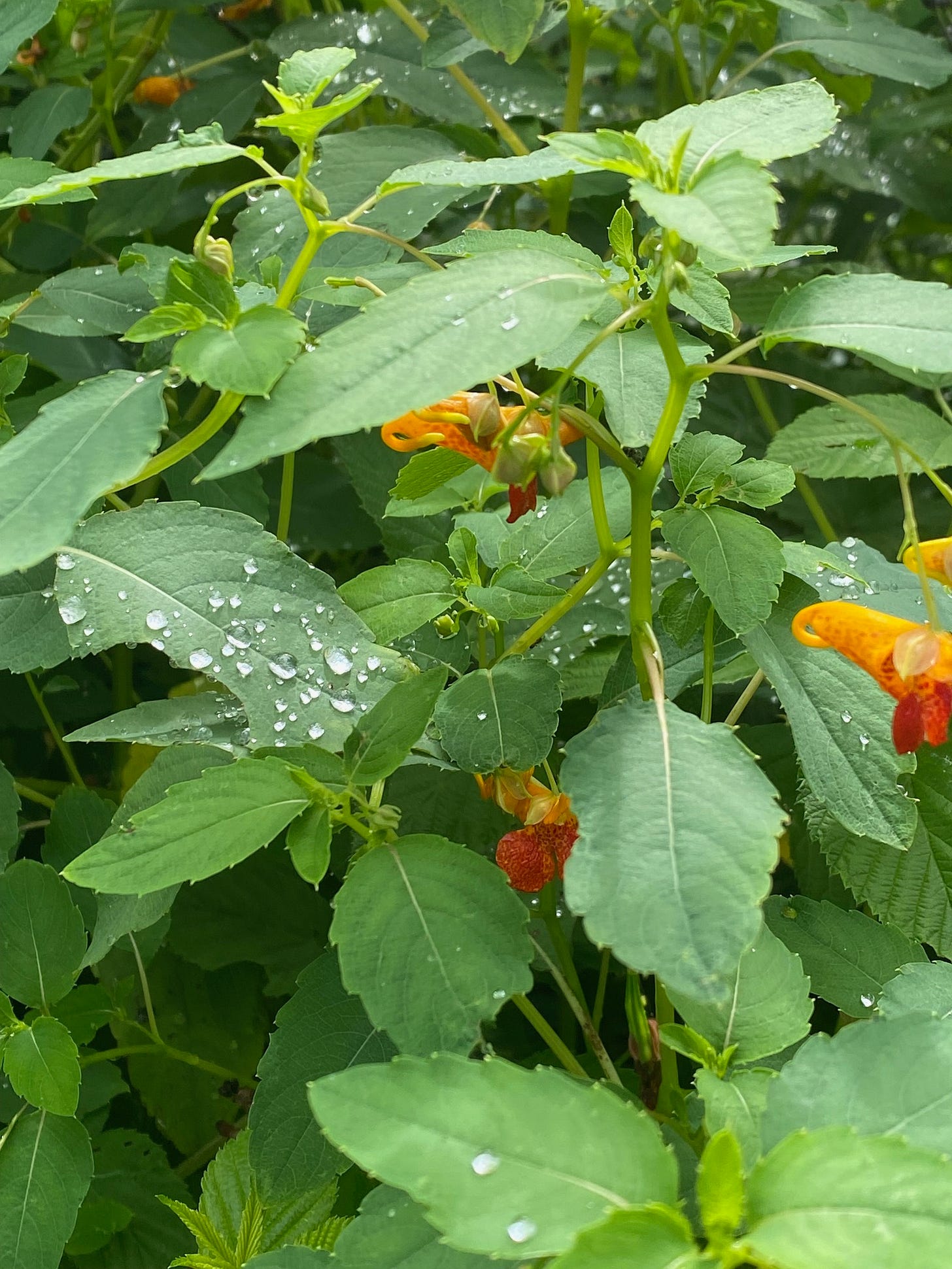
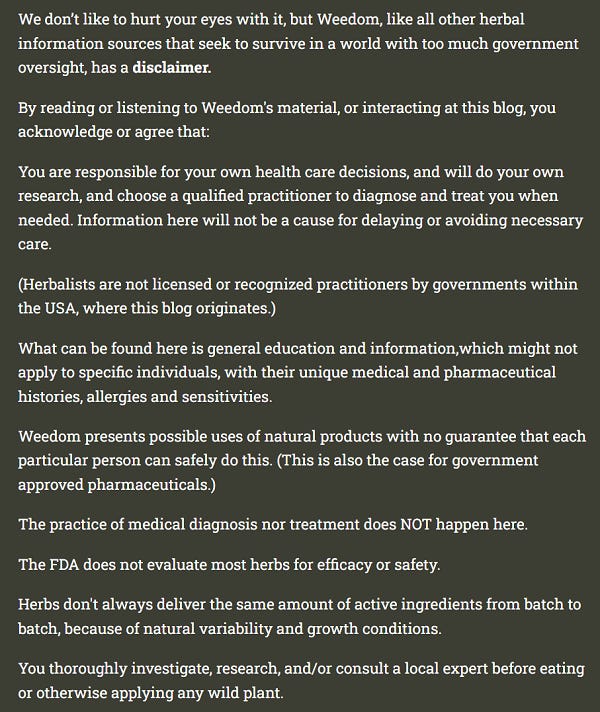
And how does one make jewelweed soap? (Not that there's any poison ivy here in Aus to be worriedabout)